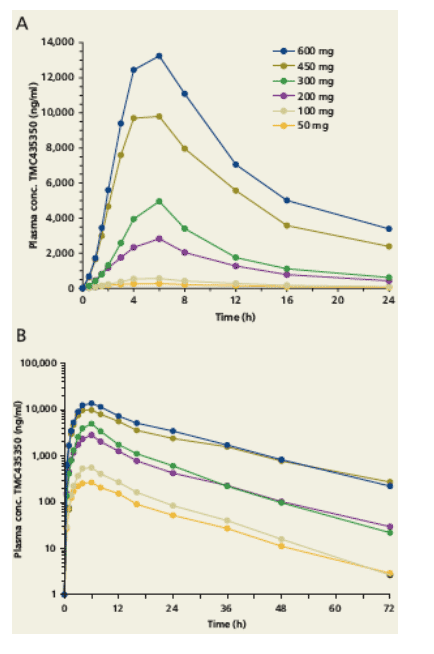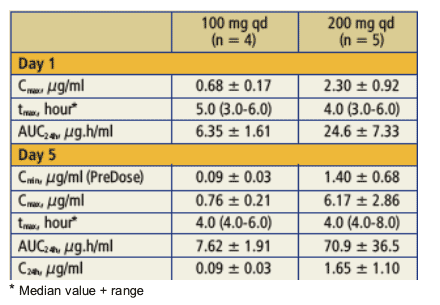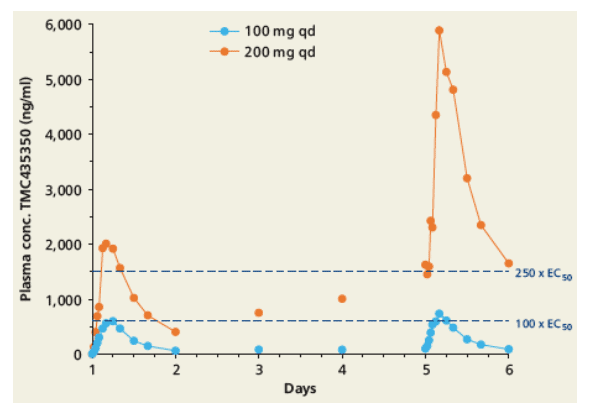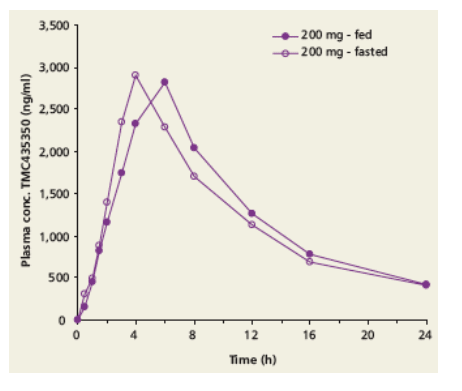 |
 |
 |
| |
Results of a Phase I Placebo-Controlled Trial in Healthy Volunteers
to Examine the Safety, Tolerability and PK of the HCV Protease Inhibitor TMC435350 after Single and Repeated Dosing in healthy volunteers
|
| |
| |
Reported by Jules Levin
AASLD, Nov 2-6, 2007, Boston, MA
Rene Verloes1, Khalid Abou Farha2, Andre van Vliet2, Gerben van 't Klooster1, Pieter Van Remoortere1, Fatima Aharchi1, Kris Marien1, Herman de Kock1, Kenneth Simmen1
1Tibotec Pharmaceuticals Ltd, Eastgate Village, Little Island, Cork, Ireland; 2PRA International EDS, Stationsweg 163, 9471 GP Zuidlaren, The Netherlands
AUTHOR CONCLUSIONS
· In this phase I study, TMC435350 was safe and well-tolerated when given to HCV-negative healthy volunteers at single oral doses up to 600 mg, and at 5 days of oral doses up to 400 mg once-daily.
· The pharmacokinetic profile of TMC435350 supports once-daily dosing.
· There is no food effect.
· The plasma levels of TMC435350 24 hours after day 5 dosing are substantially in excess of the replicon EC50 value for both 100 and 200 mg qd doses.
Minor (grade 1 only) adverse events:
- Mainly gastrointestinal tract related.
- Transient photosensitive reaction in some subjects (mild, short-lasting erythema).
TMC435350 will be further investigated following once-daily administration in HCV patients.
Introduction
This trial studied the safety, tolerability and pharmacokinetics (PK) of TMC435350, a novel HCV NS3/4A protease inhibitor, after single oral dosing and, in a second step, after 5 days of oral dosing in HCV-negative healthy volunteers.
TMC435350 (Simmen et al., 2007):
Has potent and selective enzymatic HCV NS3/4A inhibiting activity in vitro:
· genotype 1a: Ki = 0.5 nM
· genotype 1b: Ki = 0.4 nM
· inhibition of HCV NS3/4A protease was > 1,000 times stronger than inhibition of tested host proteases.
Is potent and highly selective in genotype 1 cellular replicon assays:
· EC50 = 8 nM
· EC90 = 24 nM
· minimal cytotoxicity in tested human cell lines (SI > 2,000).
Highly selective for HCV inhibition (EC50 > 10 Um against a panel of DNA and RNA viruses)
METHODS
Single and multiple ascending doses of TMC435350 were studied in HCV-negative healthy volunteers.
Single ascending dose (SAD)
· 50-600 mg TMC435350 oral solution in PEG400; 2 panels of 9 males or females, 6 of whom received TMC435350 and 3 received placebo (Figure 2A).
· Fed conditions for all doses tested followed by an investigation of effects of fasting on PK profile and exposure of a single dose of 200 mg of TMC435350 (same individuals in panel 1).
· Full PK profile was studied on the day of dosing with additional samples taken up to 72 h postdose.
Multiple ascending dose (MAD)
· 100-400 mg TMC435350 oral solution in PEG400; 4 panels of 9 volunteers: 6 subjects receiving TMC435350 solution and 3 subjects receiving placebo; except for panel 3 that had 4 subjects receiving TMC435350 and 2 placebo, and panel
4 that had 5 subjects on TMC435350 and 2 on placebo (Figure 2B).
· Safety monitoring.
· Full PK profiles were studied on days 1 and 5, with predose samples on days 2, 3 and 4.
Assessments
· Safety was closely monitored throughout and up to one month after dosing with ambulatory visits. Safety parameters included physical examination, vital signs, laboratory parameters (routine hematology, biochemistry, urinalysis), and adverse events (AEs) monitoring.
· Cardiovascular safety was intensively monitored using triplicate 12-lead ECGs and, in the MAD part only, assessment of proANP, proBNP and BNP levels, and troponin cardiac enzymes. In addition, transcutaneous echocardiography was performed pre- and post-dose.
· Data review meetings were organized using interim safety reports, and the decision to escalate the dose was taken in full consensus and approved at each step by the local ethical committee.
Bioanalysis
Plasma concentrations of TMC435350 were determined by a validated liquid chromatography tandem mass spectrometry method (LC-MS/MS) which had a lower limit of quantification (LLOQ) of 2 ng/ml.
Fig. 2: Study design for the SAD (A) and the MAD (B) part in healthy volunteers. Each session had 9 volunteers (6 active, 3 placebo) administered oral solution, taken with food (last session 200 mg taken after fasting). For MAD: starting dose of 100 mg given qd for 5 days; subsequent doses were 200 mg qd, 200 mg bid and 400 mg qd.

· Oral doses up to 600 mg were well tolerated.
· Only mild (grade 1) AEs noted.
· No grade 3 or 4 AEs noted.
· Minor effects observed were gastrointestinal tract related.
· No dose-limiting toxicity or determination of a maximum tolerated dose.
· No dose-dependent increase in AE incidence was observed.

Fig. 3: Plasma concentrations of TMC435350 after single dosing.
(A) Linear plot; (B) Semi-logarithmic plot.
Mean PK parameters and mean plasma concentration-time plots after single oral doses of TMC435350 are presented in Table 2 and Figure 3, respectively:
· Readily absorbed
· Delayed time to peak (tmax) indicates slow or prolonged absorption.
· Plasma exposure increased in more than dose proportional fashion.
Half-life was independent of dose, indicating that apparent dose-disproportionality is not associated with dose-dependent clearance.
· Good plasma exposure with a tmax of 4-6 hours and a plasma elimination half-life of ~12 hours supported once daily dosing (qd) in the MAD phase.

Multiple ascending dose (MAD)

· Multiple oral doses of TMC435350 given for 5 days up to 400 mg or placebo were well tolerated.
· No discontinuations.
· Only mild (grade 1) AEs noted.
· No grade 3 or 4 AEs noted.
· Minor effects observed were mainly gastrointestinal tract related. Mild, shortlasting erythema was noted after sun exposure in 3 subjects receiving the
200 mg bid dose.
· No dose-limiting toxicity or determination of a maximum tolerated dose.
· No clinically relevant changes from baseline on laboratory parameters, vital signs, ECG recordings and echocardiographic evaluations.
· Generally well tolerated, without a dose relationship for AE incidence.
Table 4: Mean (± standard deviation) PK parameters after
5 days of once-daily dosing of TMC435350.
Once-daily oral TMC435350 dosing yielded excellent plasma exposure:
· Day 1 PK was similar to the single-dose PK in the SAD part of the study.
· Exposure increased in a substantially more than dose-proportional fashion from 100 to 200 mg qd.
· Steady state was attained within the 5 days-dosing period for the 100 mg
qd regimen, but not for 200 mg qd. Pre-dose plasma concentrations for 200 mg qd tended to stabilize between day 4 and day 5, suggesting steady state to be achieved within approximately 7 days.
· Mean plasma levels detected 24 hours after day 5 dosing were substantially in excess of the HCV replicon EC50 value for both doses.
· Analysis of MAD panels 5 and 6 (200 mg bid and 400 mg qd) is ongoing.


Absence of food effect
Fig. 5: Mean plasma concentration-time plots after oral intake of
200 mg TMC435350, with and without food.
Food, consisting of a moderate fat breakfast, slightly delayed the absorption and did not influence the oral bioavailability of TMC435350.

|
| |
|
 |
 |
|
|